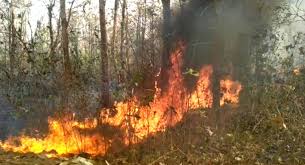Bhubaneswar/ New Delhi: From 2001 to 2022, Odisha had the highest rate of tree cover loss due to fires with an average of 238 hectares lost per year, according to the latest data from the Global Forest Watch monitoring project. Other states that follow Odisha are Arunachal Pradesh (198 hectares), Nagaland (195 hectares), Assam (116 hectares), and Meghalaya (97 hectares). The data showed India lost 35,900 hectares of tree cover due to fires from 2002 to 2022, with 2008 recording the maximum tree cover loss due to fires (3,000 hectares).
The findings acquire importance at a time when forest fires have been raging in the state’s forests owing to the rising mercury and dry weather conditions. Odisha has been experiencing the country’s worst forest fires for many years. The data further suggested that India has lost 2.33 million hectares of tree cover since 2000, equivalent to a six per cent decrease in tree cover during this period. The Global Forest Watch, which tracks forest changes in near real-time using satellite data and other sources, said the country lost 4,14,000 hectares of humid primary forest (4.1 per cent) from 2002 to 2023, making up 18 per cent of its total tree cover loss in the same period. Between 2001 and 2022, it said, forests in India emitted 51 million tonnes of carbon dioxide equivalent a year and removed 141 million tonnes of carbon dioxide equivalent a year. This represents a net carbon sink of 89.9 million tonnes of carbon dioxide equivalent a year.
An average of 51.0 million tonnes of carbon dioxide equivalent per year was released into the atmosphere as a result of tree cover loss in India. In total, 1.12 gigatonnes of carbon dioxide equivalent was emitted during this period. Forests are both a sink and a source for carbon, removing carbon dioxide from the air when standing or regrowing and emitting it when cleared or degraded. The loss of forests, thus, accelerates climate change. Tree cover loss is not always deforestation, which typically refers to human-caused, permanent removal of natural forest cover. It includes both human-caused loss and natural disturbances, and loss that is permanent or temporary.
Examples of tree cover loss that may not meet the definition of deforestation include loss from logging, fire, disease or storm damage. The data showed that 95 per cent of the tree cover loss in India from 2013 to 2023 occurred within natural forests. The maximum tree cover loss of 1,89,000 hectares occurred in 2017. The country lost 1,75,000 hectares of tree cover in 2016 and 1,44,000 hectares in 2023, the highest in the last six years. The GFW data showed that five states accounted for 60 per cent of all tree cover loss between 2001 and 2023.







































